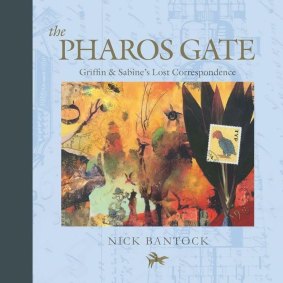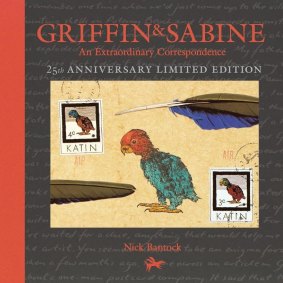By Thuy On
"How strange to have a paper love." Devotees of the bestselling works of Nick Bantock will recognise that this sentiment comes from Griffin Moss, the reclusive London postcard designer. His declarative wonder is directed towards Sabine Strohem, fellow artist and soulmate who lives in the South Pacific.
Twenty-five years ago, their correspondence first delighted romantics and lovers of the humble epistle in Griffin & Sabine, Bantock's picture book for adults. With surreal and dreamy images adorning their fictional postcards and letters, Griffin and Sabine were one another's creative muses and Bantock's book became a classic; a gorgeously tactile hybrid of words and pictures.

The Pharos Gate completes the Griffin & Sabine series Nick Bantock began 25 years ago.
His subsequent books (including Sabine's Notebook and The Golden Mean) continued to climb the bestseller lists and now there's a final volume in the series, The Pharos Gate. Visually it's as decorative as the others, and constructed in the same multimedia manner: with letters that have to be plucked from their envelopes – a canny literary ploy that offers the reader a voyeuristic thrill.
Bantock calls it "the missing link that ends the first trilogy and signposts the second". Asked why he took so long to produce The Pharos Gate, he denies it was pressure from his fans or his publisher.

The Pharos Gate by Nick Bantock.
"It has a lot more to do with my process of gradual understanding and less to do with audience or market desire." He adds, "The only pressure came from the characters within; Griffin and Sabine are part of my mythology and their dialogue in both word and image represents my idiosyncratic way of comprehending existence".
The Pharos Gate is billed as their "lost correspondence" and, perhaps, finally resolves the question of whether Griffin and Sabine ever meet across time and space. One of the (frustrating) joys of the books is their obliqueness; Bantock doesn't offer literal meanings but teases with psychological and magic realism possibilities.
Despite their telepathic connection and their striving towards one another, readers have wondered why the star-crossed pair constantly elude one another. Is their connection a purely metaphysical one? Do they exist in a parallel universe? Is Sabine a figment of Griffin's overheated imagination or vice versa? Can there ever be an ending for this strange dance in which they've never yet touched?
Bantock (who once trained as a psychotherapist) is bemused by the notion that "ends can be tied-up. Particularly in this case, where there are many levels layered over the top of one another (love, adventure, mystery, hero's journey, search for self, mythical and alchemical marriage) I can't possibly control interpretations".

Griffin & Sabine by Nick Bantock.
"There's also, of course, creative licence: Politicians give answers; artists ask questions."
Bantock strove to make "the art and the events as timeless as possible so that the reader/viewer could return years later and see the changes in themselves when they re-interpret the tale from the present perspective."
In The Pharos Gate, the mysterious stalker Victor Frolatti is (for reasons unknown) threatening again to thwart the lovers. "You will not meet. Your world and hers will always circle one another," he warns Griffin. But do Frolatti and his malevolent beaked and furred minions succeed in keeping the pair apart as they travel to Alexandria to convene at this designated spot, a place where the ancients had revered as a portal to the underworld?
There will be no spoilers here but Bantock offers some further questions to ponder, "What happens when you let your imagination pass through the gate? Where does that door lead? Think of it as a tunnel to the events of the second trilogy, a right of passage that can be understood as both natural and abstract".
Bantock's resume is dauntingly impressive; he has sold 5 million copies of his 27 books, 11 of them bestsellers, translated into 13 languages. His artworks (paintings, sculptures, collages and prints) have been widely exhibited and have appeared on 300 book covers.
Anything he can't do? Yes, apparently he can't swim, has never ridden a horse, has atrocious spelling and a singing voice as "flat as a pancake".
When I commend him on revitalising the art of penmanship in an age of email and text messages, Bantock responds, "All I want to do is remind those trapped in the light of the blue screen that the computer is also a tool, not a conclusion. Progress is in the quality of content, not in speed of delivery."
For print book lovers everywhere, he adds reassuringly, "I'm pretty sure the tactile experience cannot be superseded".
The Pharos Gate
Nick Bantock
Chronicle Books, $45